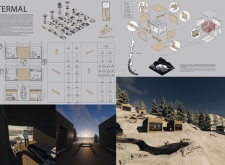5 key facts about this project
At its core, this project represents more than just a collection of living spaces. It integrates architecture with the environment, illustrating the potential for sustainable practices that respect both the land and its users. The modular design approach allows flexibility in arrangement and functionality, enabling spaces to be configured in multiple ways to accommodate various community dynamics and individual preferences. By fostering this adaptability, the project illustrates a modern understanding of architecture that prioritizes human connections and social interactions within a cohesive living environment.
The functional aspects of the Termal project are evident in its attention to user experience and community engagement. Various communal spaces encourage collaboration among residents, creating opportunities for social gatherings and shared experiences. These areas are thoughtfully integrated within the broader landscape, emphasizing outdoor living and interaction with nature. This focus on community reflects a growing trend in contemporary architecture, where building design is increasingly recognized as a catalyst for social interaction.
In terms of materiality, the project utilizes natural and locally sourced materials that resonate with the region's characteristics. Wood serves as a primary construction material, offering thermal insulation and a connection to the surrounding forested landscape. Large expanses of glass are strategically placed to maximize natural light and provide unobstructed views, merging the interior spaces with the exterior environment. This choice of materials reinforces the project’s commitment to sustainability while also addressing aesthetic considerations. The thoughtful combination of materials not only enhances the living experience but also ensures that the architecture harmonizes with its surroundings.
Unique design approaches manifest in the project's emphasis on modularity. Each unit can be configured independently or joined with others to form larger communal or private spaces, responding effectively to the changing needs of inhabitants over time. This flexibility is essential in a region where climate conditions can vary significantly, allowing for adjustments to be made in response to seasonal shifts. The thoughtful design ensures that each space can function effectively both independently and collaboratively, illustrating a comprehensive understanding of contemporary living.
Moreover, the layout and spatial organization of Termal highlight the importance of human scale within architectural design. The project has been planned to create an inviting atmosphere, with external areas designed for relaxation and interaction. The careful placement of terraces and outdoor seating arrangements encourages residents to engage both with each other and the stunning natural landscape that surrounds their homes.
The Termal project stands as a testament to modern architectural principles that advocate for ecological sensitivity, community-oriented spaces, and design adaptability. These elements work together to create a living environment that fosters well-being, connection, and harmony with nature. For those interested in exploring the depths of this innovative project, detailed architectural plans, sections, and designs available in the presentation provide essential insights into the strategic thinking and creative processes behind this architectural endeavor. The sophisticated interplay between form, function, and environment invites further investigation and appreciation of what Termal has to offer in the realm of contemporary architecture.























